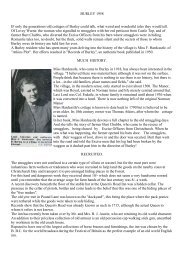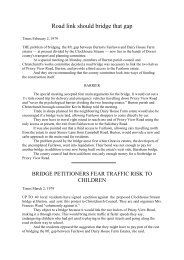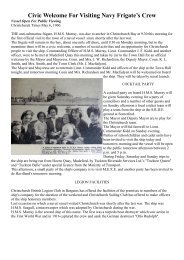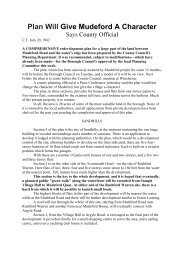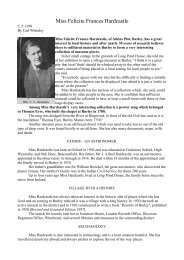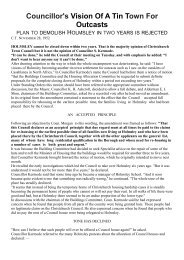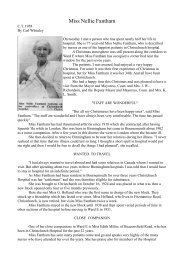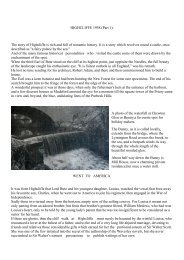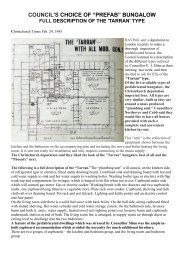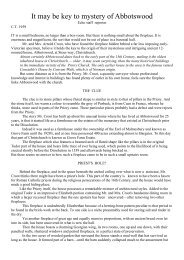Man and the Christchurch Avon 1963 - royhodges.co.uk
Man and the Christchurch Avon 1963 - royhodges.co.uk
Man and the Christchurch Avon 1963 - royhodges.co.uk
You also want an ePaper? Increase the reach of your titles
YUMPU automatically turns print PDFs into web optimized ePapers that Google loves.
This resulted in an order prohibiting <strong>the</strong> removal of ironstone from <strong>the</strong> Head on 18/10/1854 —<br />
especially below high water mark (h.w.m.). Holloway ceased shore removal in October 1854, but legal<br />
disputes over <strong>the</strong> right of <strong>the</strong> owner to lease <strong>the</strong> shore <strong>and</strong> Head to <strong>the</strong> ironmining <strong>co</strong>mpany (<strong>and</strong><br />
proceedings against o<strong>the</strong>rs raising cement stone from Totl<strong>and</strong> Bay) were <strong>co</strong>ntinuous. A notice to stop stonetaking<br />
was served on those mining on <strong>the</strong> Head <strong>and</strong> those dredging in <strong>the</strong> Bay as infringements of <strong>the</strong> 1854<br />
Order were still taking place. The notice read :<br />
"Take Notice that you <strong>and</strong> all o<strong>the</strong>rs are forbidden to dig <strong>and</strong> excavate, break, dredge up or o<strong>the</strong>rwise<br />
disturb, take or remove any stone, shingle or o<strong>the</strong>r soil or matter at or from <strong>the</strong> shore below High Water<br />
Mark at <strong>Christchurch</strong> Head or <strong>the</strong> waters adjacent <strong>the</strong>reto, or at or from any part of <strong>the</strong> Bays called Poole<br />
Bay <strong>and</strong> <strong>Christchurch</strong> Bay or <strong>the</strong> shores <strong>the</strong>reof, <strong>the</strong> same being <strong>the</strong> property of Her Majesty. (Signed) Wm.<br />
Robson, Solicitor to <strong>the</strong> Admiralty." Much of <strong>the</strong>se re<strong>co</strong>rds are in <strong>the</strong> Druitt Papers in Red House Museum.<br />
LEGAL RIGHTS<br />
A fur<strong>the</strong>r Admiralty Inquiry in 1881 resulted in fur<strong>the</strong>r difficulties over legal rights, <strong>and</strong> several public<br />
petitions were made for Admiralty action. Finally, large-scale work on <strong>the</strong> seaward Head, even above high<br />
water mark, was stopped in 1865 as serious erosion was causing fur<strong>the</strong>r alarm in <strong>Christchurch</strong>, especially as<br />
<strong>the</strong> eastward drift of shore debris was seriously affecting <strong>the</strong> harbour mouth.<br />
Mr. Holloway had purchased, in 1856, a piece of l<strong>and</strong> near <strong>the</strong> Bell Inn at Seend in Wiltshire, <strong>and</strong> had<br />
extracted over 4,000 tons of iron ore from <strong>the</strong> newly-dis<strong>co</strong>vered field <strong>the</strong>re that year, all of which was<br />
sent to South Wales for smelting. (O<strong>the</strong>r persons joined in this new enterprise, <strong>and</strong> 78,000 tons of ore<br />
raised from <strong>the</strong> Seend field in 1855-61 <strong>and</strong> 86,000 tons in 1871-74). It seems probable that Holloway<br />
found this Wiltshire iron ore more profitable to exploit than that at Hengistbury Head, <strong>and</strong> this would<br />
explain a declining interest in <strong>the</strong> latter.<br />
A small amount of work <strong>co</strong>ntinued on <strong>the</strong> north side of <strong>the</strong> Head until 1880, but <strong>the</strong> amount raised was<br />
small. The re<strong>co</strong>rds of iron ore production for <strong>the</strong> years 1859-61 show a decline in <strong>the</strong> production of<br />
Hampshire-raised ore, <strong>and</strong> almost all that re<strong>co</strong>rded must have <strong>co</strong>me from <strong>the</strong> <strong>Christchurch</strong> Harbour<br />
workings.<br />
Hampshire<br />
1859 1860 1861<br />
9,725 6,119 4,008 tons<br />
U.K. total<br />
1859 1860 1861<br />
7,876,581 8,024,204 7,215,518 tons<br />
Never<strong>the</strong>less, <strong>the</strong> totals of thous<strong>and</strong>s of tons a year reveals clearly <strong>the</strong> cause of <strong>the</strong> serious erosion problems<br />
in <strong>the</strong> Hengistbury Head area. Ironstones are again accumulating on <strong>the</strong> beach on <strong>the</strong> south side of<br />
Hengistbury Head <strong>and</strong> b<strong>and</strong>s of <strong>the</strong> stones can be seen in <strong>the</strong> cliffs, while from <strong>the</strong> air <strong>the</strong> workings of <strong>the</strong><br />
old quarry <strong>and</strong> <strong>the</strong> jetty in <strong>the</strong> Harbour can still be clearly traced. Erosion, however, despite <strong>the</strong> check of<br />
fallen stones <strong>and</strong> <strong>the</strong> old eastern ironstone-<strong>co</strong>ncrete breakwater, <strong>co</strong>ntinues apace, <strong>and</strong> it seems likely that <strong>the</strong><br />
Head will be fur<strong>the</strong>r seriously eroded by undermining <strong>and</strong> l<strong>and</strong>slip unless extensive <strong>co</strong>ast-protection works<br />
are undertaken in <strong>the</strong> area.<br />
SILTING PROBLEMS<br />
During <strong>the</strong> 19th Century, <strong>the</strong>refore, <strong>the</strong> busy ironstone-mining increased <strong>the</strong> harbour-entrance silting<br />
problems on which so many surveyors had already given <strong>the</strong>ir opinions. In 1860 <strong>the</strong>re were suggestions that<br />
<strong>the</strong> Admiralty might buy Hengistbury Head, put in a harbour groyne <strong>and</strong> build a Hospital <strong>the</strong>re, but l<strong>and</strong><br />
<strong>co</strong>sts rose with <strong>the</strong> increase in Bournemouth's influence, <strong>and</strong> <strong>the</strong> plans were ab<strong>and</strong>oned. The decline in<br />
harbour trade with <strong>the</strong> <strong>co</strong>ming of <strong>the</strong> railways <strong>and</strong> <strong>the</strong> cessation of <strong>the</strong> ironstone working caused a lessening<br />
interest in <strong>Christchurch</strong> as a port of any importance, <strong>and</strong> in 1883 it was described as "silted up <strong>and</strong> choked<br />
with weeds."<br />
With <strong>the</strong> <strong>co</strong>ming of <strong>the</strong> railways to <strong>Christchurch</strong> in 1862 <strong>and</strong> 1888 <strong>and</strong> <strong>the</strong> growth of a nation-wide railway<br />
network it would be thought that <strong>the</strong> harbour improvement schemes would have been dropped. However, it



